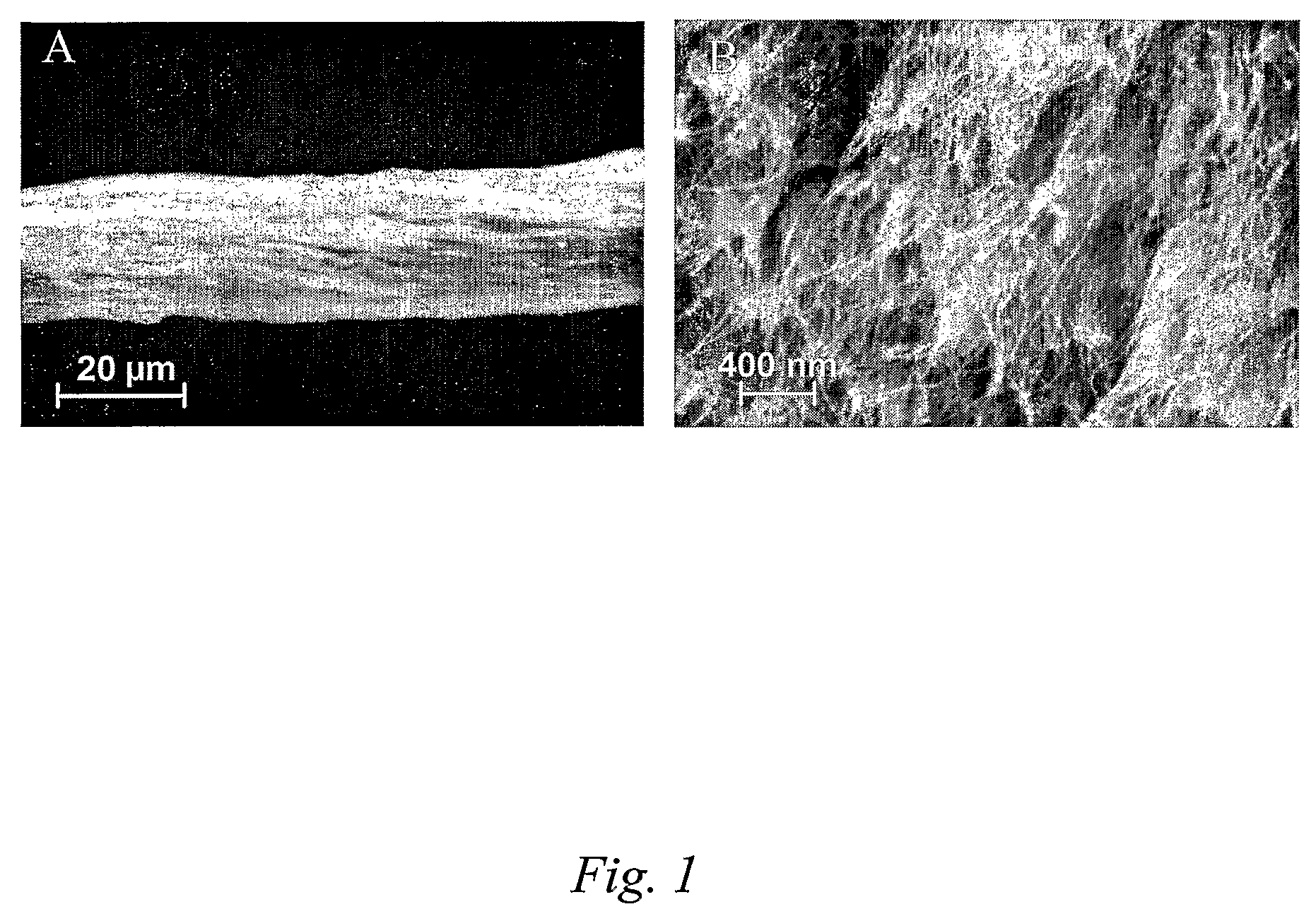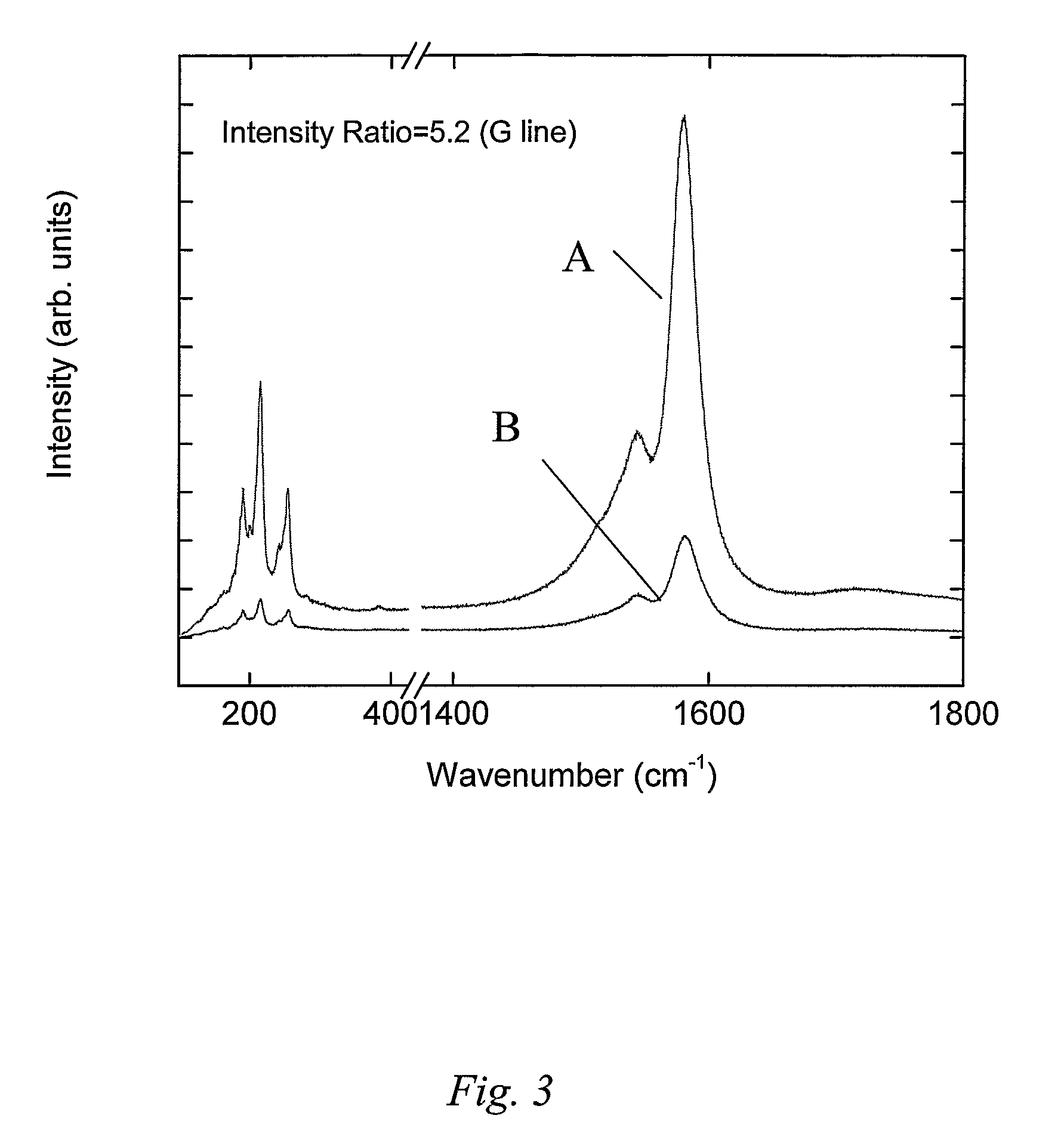Polymer-free carbon nanotube assemblies (fibers, ropes, ribbons, films)
a carbon nanotube and polymer-free technology, applied in the direction of electrolytic capacitors, transportation and packaging, mixing, etc., can solve the problems of insoluble swnts, hindering application development, and no nanotube manufacturing methods available presently
- Summary
- Abstract
- Description
- Claims
- Application Information
AI Technical Summary
Benefits of technology
Problems solved by technology
Method used
Image
Examples
example 1
[0137]This Example illustrates the production of polymer-free carbon nanotube fibers that have variously shaped cross-sections, including hollow nanotube fibers, in accordance with some embodiments of the present invention. Single-walled carbon nanotubes produced by high pressure carbon monoxide reaction (HiPco nanotubes from Carbon Nanotechnologies Inc., 16200 Park Row, Houston, Tex. 77084-5195) were used. These SWNTs, in the amount of 0.6 wt % were dispersed in 15 ml of aqueous 1.2 wt % lithium dodecyl sulfate (LDS) surfactant with the aid of a horn-type ultra-sonicator (Branson Sonifier 250) at a power level of 50 W applied for 18 minutes. Immediately after sonication, the dispersion was loaded into a syringe; the syringe was attached to a syringe pump (KD Scientific) and coupled to a 20 gauge needle having a cylindrical inner diameter of 0.0230 inches. A round glass container was filled with flocculating agent comprising 37% hydrochloric acid (EMD), and the filled container was ...
example 2
[0138]This Example describes measurements of mechanical properties for the polymer-free flocculation spun fibers of EXAMPLE 1. Measurements of fiber tensile stress vs. strain measurements were typically carried out on 15 mm lengths of the fiber in an Instron 5848 Micro Tester. Fiber weight was determined with a microbalance. Recorded force was normalized by weight per fiber length (g / cm) so that specific values for stress and Young's modulus are reported in units of MPa / (g / cm3) and GPa / (g / cm3), respectively. This density normalization was used to eliminate uncertainties in fiber cross-sectional area, which can be quite large when this cross-section is irregular. Such density-normalized mechanical properties are especially important when the weight of structural elements is important, such as for aerospace applications. This approach provides a lower limit on the tensile strength at the location of fiber failure. The obtained specific strength and specific Young's modulus for the pol...
example 3
[0139]This Example illustrates the production of polymer-free nanotube fibers that comprise mixtures of carbon single wall and multi-wall nanotubes. Hybrid SWNT / MWNT polymer-free carbon nanotube fibers were prepared as follows. A mixture of single-walled HiPco carbon nanotubes (Carbon Nanotechnologies Inc.) and multi-walled carbon nanotubes (Sunnano Co., 339 East Beijing Road, Nanchang, Jiangxi 330029, P.R. China) were used. These SWNTs and MWNTs were mixed in a ratio of 25:75 and dispersed in an amount of 0.6 wt % in 15 ml of aqueous 1 wt % lithium dodecyl sulfate (LDS) surfactant with the aid of a horn sonicator (Branson Sonifier 250) at a power level of 50 W applied for 18 minutes. Like in EXAMPLE 1, the prepared dispersion was injected into a flow of 37% hydrochloric acid, thus forming a gel fiber that was washed, drawn, and dried by a procedure essentially identical to the one described in EXAMPLE 1.
PUM
| Property | Measurement | Unit |
|---|---|---|
| temperature | aaaaa | aaaaa |
| temperature | aaaaa | aaaaa |
| diameter | aaaaa | aaaaa |
Abstract
Description
Claims
Application Information
 Login to View More
Login to View More - R&D
- Intellectual Property
- Life Sciences
- Materials
- Tech Scout
- Unparalleled Data Quality
- Higher Quality Content
- 60% Fewer Hallucinations
Browse by: Latest US Patents, China's latest patents, Technical Efficacy Thesaurus, Application Domain, Technology Topic, Popular Technical Reports.
© 2025 PatSnap. All rights reserved.Legal|Privacy policy|Modern Slavery Act Transparency Statement|Sitemap|About US| Contact US: help@patsnap.com



